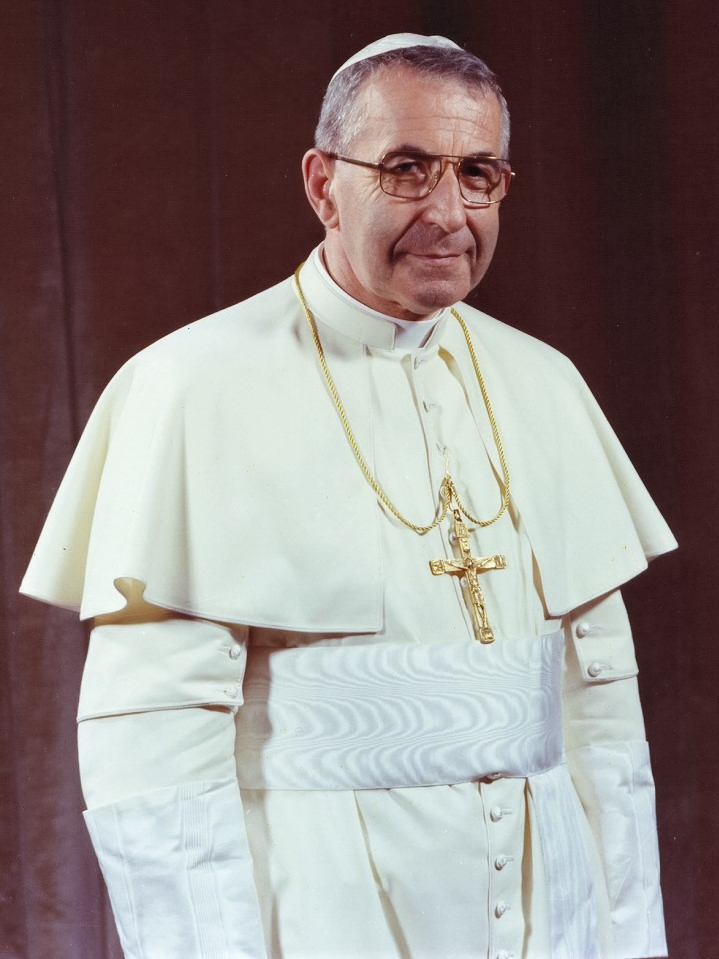MAL ROGERS looks at the momentous events in the Vatican 45 years ago in August 1978
 Pope Paul VI (picture in public domain)
Pope Paul VI (picture in public domain)On August 6, 1978, Cardinal Jean-Marie Villot, the Vatican’s Secretary of State — known as the cardinal camerlengo — approached the body of Pope Paul VI. Using the traditional silver hammer he tapped the pontiff’s head. He then solemnly employed the words of a question asked over the corpses of popes for centuries. Using the pope’s birth name he asked “Giovanni Battista Montini are you dead?” The cardinal asked this question three times, and then announced, “Pope Paul is truly dead.”
By the summer of 1978, Pope Paul VI, then aged 80, had been Bishop of Rome for 15 years. But the papal duties were weighing heavily on him as he faced sustained opposition from various factions within the Church — both conservatives and progressives.
On August 6, Pope Paul suffered a heart attack, his death sparking off a series of events that would mire the church in controversy and gossip.
The conclave subsequently elected Albino Luciani, Patriarch of Venice, to become pope. Luciani appeared genuinely reluctant to take on the job, with many of his friends believing he might well refuse. But he was duly elected as Supreme Pontiff of the Western Church. In honour of his two predecessors Cardinal Luciano took the name John Paul I.
New title decided on, the Pope phoned Monsignor Matteo Ducoli, Bishop of his own diocese of Belluno, to tell him he had a new boss.
Some 33 days after his election, at 5.30am on September 29, his private secretary Father John Magee — currently emeritus Bishop of Cloyne — was reported to have found Pope John Paul dead in his bed. It later emerged that it was one of the nuns who cared for the pope who had in fact made the discovery. But to announce to the world that a woman had found the pope in his bed seemed not quite de rigueur to the Vatican authorities. So a story was quickly concocted round the Newry-born Father Magee.
At 6.20 am Albion Luciano’s family were phoned once again. The papal secretary,Father Magee, a fluent Italian speaker, simply said: “Zio Albino e morto.” Uncle Albino is dead.
 Pope John Paul I (picture in public domain)
Pope John Paul I (picture in public domain)The Pope’s niece drove down to the local church in Canale d’Agordo to give the news to the parish priest. Don Rinaldo Andrich had just finished Mass. He turned to the small congregation before it dispersed and said, “They tell me the Pope is dead.” To him fell the duty of making the first official announcement of the pope's death to the public.
Conspiracy theories that Pope John Paul I Had been murdered soon surfaced. Certainly, there were suspicions of wrongdoing. For a man of 67 he was in robust good health; there was no autopsy, no post mortem.The timing of contacting the undertakers came under scrutiny.
In the days following John Paul’s death a rumour circulated that he may have been on the point of exposing a major financial scandal within the Vatican Bank. Major criminals would certainly have gone to any lengths to prevent this.
But in reality, Pope John Paul I almost certainly died of natural causes. The Curia panicked, and subsequently got caught out in a catalogue of needless lies about his death and discovery of his body.
After the death of Pope John Paul I the conclave reconvened at the Sistine Chapel on October 14.
A new group of candidates, drawn from across the spectrum in the College of Cardinals, began to emerge. The group included, as well as several Italians, both the names of Basil Hume and Karol Wojtyla.
The Englishman made the early running, with The Guardian in Britain even predicting that he was something of a shoo-in. But British newspapers hold little sway in Vatican matters. Irish saints, however, do. A Vatican commentator invoked the prophesies of St Malachy (1094-1148) Archbishop of Armagh. Corrado Balducci, writing in the Osservatore Romano, the Vatican newspaper, warned of Malachy’s prediction that the coming papal reign would herald in a great cataclysm.
Even though the authenticity of Malachy’s prophesies are viewed with scepticism (to put it mildly) the article helped add to the tension in the Vatican, and may even have been instrumental in gaining votes for right wing candidates.
On October 15, 1978 — 45 years ago this month — a wisp of white smoke appeared. Cardinal Felici, the Cardinal Deacon, announced from the central balcony of St Peter’s, “Habemus papam!” Cardinal Karl Wojtyla, Archbishop of Krakow, had been elected Pope John Paul II.
It seems likely that Cardinal Wojtyla only emerged after all the Italian candidatures had failed due to a split between liberals and hard line conservatives. For the first time since 1522, the Catholic world had a non-Italian Pope.
 Pope John Paul II (picture Wikimedia Commons)
Pope John Paul II (picture Wikimedia Commons)Surprisingly, 1978 isn’t the only year in the history of the Catholic Church when three popes have sat in the Vatican. The latest was in 1605, when the Vatican started off the year with Pope Clement VIII. He was followed by Pope Leo XII who died after 27 days. Pope Paul V succeeded him.
The very first year of three popes on 827 when Eugene II, Valentine and Gregory IV consecutively held the position of Bishop of Rome. Pope Valentine’s papal reign lasted only 41 days.

